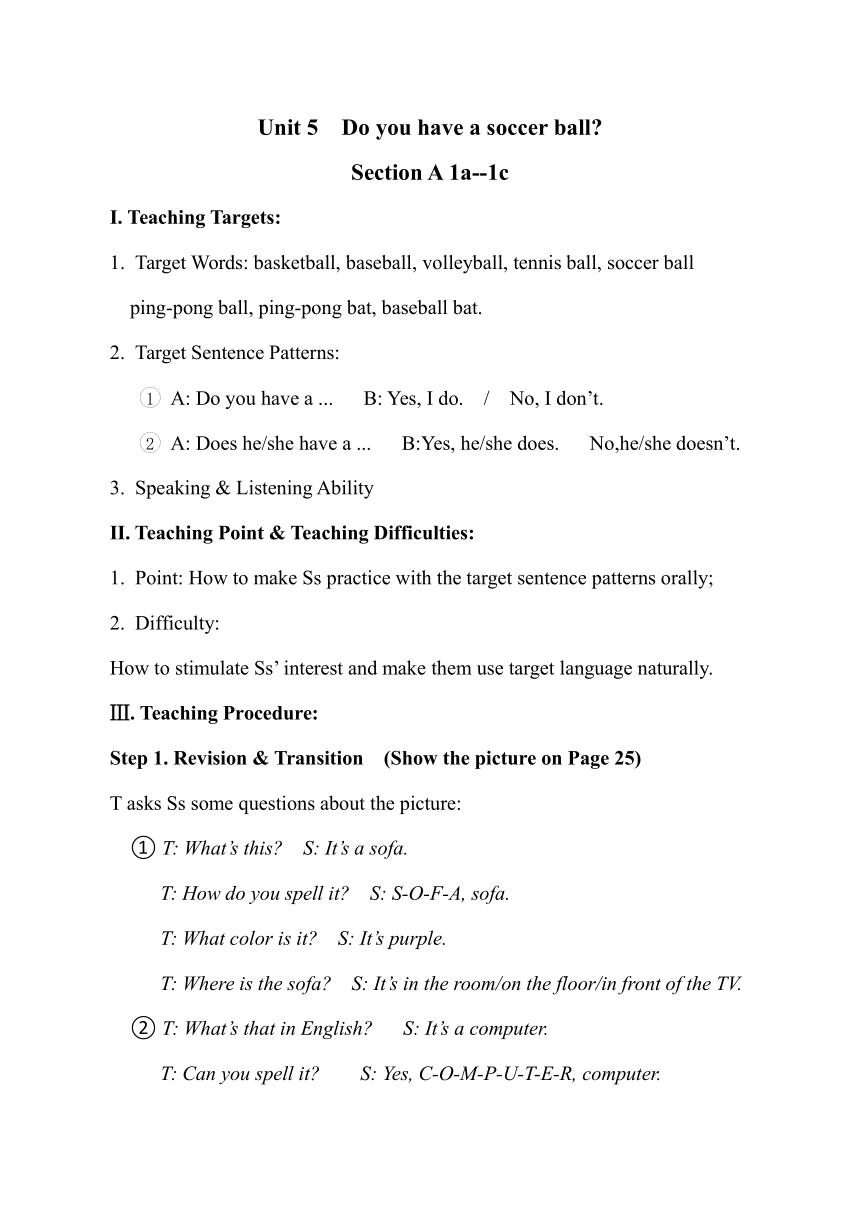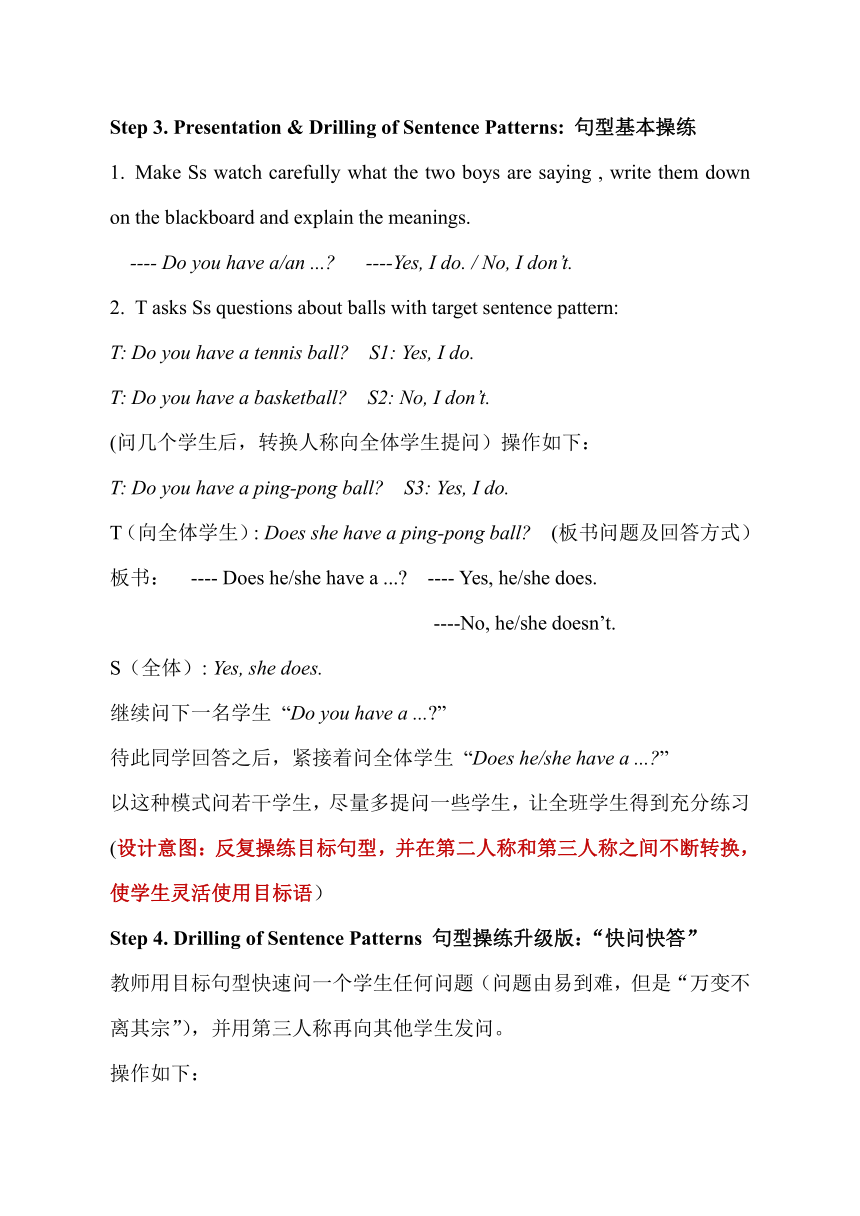Unit 5 Do you have a soccer ball? Section A 1a-1c 教学设计
文档属性
| 名称 | Unit 5 Do you have a soccer ball? Section A 1a-1c 教学设计 |  | |
| 格式 | docx | ||
| 文件大小 | 2.9MB | ||
| 资源类型 | 教案 | ||
| 版本资源 | 人教新目标(Go for it)版 | ||
| 科目 | 英语 | ||
| 更新时间 | 2023-09-16 10:14:59 | ||
图片预览



文档简介
Unit 5 Do you have a soccer ball
Section A 1a--1c
Ⅰ. Teaching Targets:
Target Words: basketball, baseball, volleyball, tennis ball, soccer ball
ping-pong ball, ping-pong bat, baseball bat.
Target Sentence Patterns:
A: Do you have a ... B: Yes, I do. / No, I don’t.
A: Does he/she have a ... B:Yes, he/she does. No,he/she doesn’t.
Speaking & Listening Ability
Ⅱ. Teaching Point & Teaching Difficulties:
Point: How to make Ss practice with the target sentence patterns orally;
Difficulty:
How to stimulate Ss’ interest and make them use target language naturally.
Ⅲ. Teaching Procedure:
Step 1. Revision & Transition (Show the picture on Page 25)
T asks Ss some questions about the picture:
① T: What’s this S: It’s a sofa.
T: How do you spell it S: S-O-F-A, sofa.
T: What color is it S: It’s purple.
T: Where is the sofa S: It’s in the room/on the floor/in front of the TV.
② T: What’s that in English S: It’s a computer.
T: Can you spell it S: Yes, C-O-M-P-U-T-E-R, computer.
T: Is it on the sofa S: No, it isn’t. It’s on the desk.
(设计意图:让学生复习之前学过的句型,自然过渡到新单元)
T:OK, in this picture, we can also see some balls. That’s what we will learn in this unit. (板书标题和关键词)
Step 2. Presentation of Words:
Show Ss some pictures of balls(将图片用磁贴贴在黑板上), and make Ss repeat after T. (一一将单词写在相应图片下,并强调在拼写上左边三个是合在一起的,右边三个是分开的,bat是带网的球拍,racket是不带网的。)
Check:
①将图片全部从黑板摘下,打乱顺序,一一举起来问学生
T: What’s this How do you spell it
②选择两名学生将图片贴回黑板上相应单词的位置,看是否能贴对
③利用pad虎口拔牙游戏检测、巩固词汇
④Work on 1a (P. 25)
Step 3. Presentation & Drilling of Sentence Patterns: 句型基本操练
Make Ss watch carefully what the two boys are saying , write them down on the blackboard and explain the meanings.
---- Do you have a/an ... ----Yes, I do. / No, I don’t.
T asks Ss questions about balls with target sentence pattern:
T: Do you have a tennis ball S1: Yes, I do.
T: Do you have a basketball S2: No, I don’t.
(问几个学生后,转换人称向全体学生提问)操作如下:
T: Do you have a ping-pong ball S3: Yes, I do.
T(向全体学生): Does she have a ping-pong ball (板书问题及回答方式)
板书: ---- Does he/she have a ... ---- Yes, he/she does.
----No, he/she doesn’t.
S(全体): Yes, she does.
继续问下一名学生 “Do you have a ... ”
待此同学回答之后,紧接着问全体学生 “Does he/she have a ... ”
以这种模式问若干学生,尽量多提问一些学生,让全班学生得到充分练习(设计意图:反复操练目标句型,并在第二人称和第三人称之间不断转换,使学生灵活使用目标语)
Step 4. Drilling of Sentence Patterns 句型操练升级版:“快问快答”
教师用目标句型快速问一个学生任何问题(问题由易到难,但是“万变不离其宗”),并用第三人称再向其他学生发问。
操作如下:
T:Do you have a ping-pong ball S1: Yes, I do.
T: Do you have a dog S1: No, I don’t.
T(向全班): Does she have a dog S(全体):No, she doesn’t.
T: Do you have a volleyball S2: No, I don’t.
T: Do you have a brother S2: Yes, I do.
T: Does your brother have a computer game S2: No, he doesn’t.
T(向全班): Does she have a volleyball S(全体): No, she doesn’t.
T: (向全班)Does she have a brother S(全体):Yes, she does.
T: (向全班)Does her brother have a computer game
S(全体):No, he doesn’t.
(设计意图:这一环节要求被提问者和其他同学都要聚精会神地听、记,并迅速做出判断,在这一过程中难免会出现错误,这正是学习的好机会,教师可不必立马指出错误,可以重复一遍再让同学们自己找出说错的地方,从而让他们对于目标语的运用越来越准确自如。但这一环节顺利进行的前提是:上一环节同学们要练习得足够充分。)
Step 5. Drilling of Sentence Patterns 句型操练加强版:“问你想问”
任意选一名学生站讲台上,其他学生举手,讲台上的学生选一名同学向他提三个问题,要求:
必须使用目标句型 “Do you have a/an ... ” 或
“Does he/she have a/an...”来问
第一个问题必须问球类,第二个问题可以是任何其感兴趣的,第三个问题要问大家。
操作如下:
S1: Do you have a baseball S: Yes, I do.
S1: Do you have a girl friend S: No, I don’t. (这种“八卦类”问题是同学们问得较多的,也最能吸引他们的注意力)
S1(向全班): Does he have a girl friend S全:No, he doesn’t.
(设计意图: 上一环节学生练习了如何回答,这一环节加上了如何提问。第一个问题问球类,让学生复习巩固今日所学单词;第二个问其他任意他们感兴趣的,跳出书本框架,充分调动学生的主观能动性,让他们在语境当中自然使用目标句型;第三个问题问其他同学,目的在于练习从第二人称到第三人称的转化。这一环节让同学们在听和说、问和答、第二人称和第三人称之间来回切换,从而得到多方面的练习。)
Step 6. Conclusion. 结合板书总结今日所学内容
Step 7. Practice: 填空
——你有足球吗? ——我没有。
----_____ you have a _______ ________. ---- No, I _______.
——你妹妹有网球吗? ——她有。
----_____ your sister _______ a _______ ________ ---- Yes, she ______
——他有乒乓球吗? ——不,他没有。
----______ he ________ a ________ _________ ---- No, he _______.
——他哥哥有篮球吗? ——不,他没有。
---- _______ his brother _______ a _________ ----No, he ________.
——你爸爸有手表吗? ——他有。
---- _______ your father _______ a _________ ----Yes, he ________.
Step 8. Homework:
Memorize the target words;
同桌相互问以下问题并将其完善、记录下来,下节课作报告。
Do you have a ________ (球类) ___________________________
Do you have a ________(文具类) ___________________________
Do you have a brother / sister __________________________
Does your sister / brother have a __________(任意) ______________
板书设计:
Part 1:
New Words:
Part 2:
Sentence Patterns:
----Do you have a/an ... ---- Yes, I do. / No, I don’t
----Does he/she have a/an ... ----Yes, he/she does.
---- No, he/she doesn’t.
教学反思:
本教学设计有以下几个亮点:
注重提问的质量。这些问题看似漫不经心,但却是精心设计,让学生
在一问一答中不知不觉地练习了目标语,课堂较注重目标语的语用性,而不是一味地让学生机械练习;
本节课堂不拘泥于课本框架,而是以学生兴趣为切入点使学生在听、
说方面得到训练,符合中学生心理特征;
教学设计环环相扣,从开始的以旧带新、新词展示与检测、句型展示
与基本操练,到“快问快答”句型操练难度升级、“问我想问”句型操练进一步强化,最后小结、练习题巩固,让学生循序渐进地接近知识、学习知识、操练知识、掌握知识,符合人的认知规律。
存在的缺陷:
课堂活动以教师问、学生答或学生问、学生答为主,问题环节设置得很充分,但却没有小组活动环节,这样的话,少数内向、被动的学生就不能够得到有效锻炼。
Section A 1a--1c
Ⅰ. Teaching Targets:
Target Words: basketball, baseball, volleyball, tennis ball, soccer ball
ping-pong ball, ping-pong bat, baseball bat.
Target Sentence Patterns:
A: Do you have a ... B: Yes, I do. / No, I don’t.
A: Does he/she have a ... B:Yes, he/she does. No,he/she doesn’t.
Speaking & Listening Ability
Ⅱ. Teaching Point & Teaching Difficulties:
Point: How to make Ss practice with the target sentence patterns orally;
Difficulty:
How to stimulate Ss’ interest and make them use target language naturally.
Ⅲ. Teaching Procedure:
Step 1. Revision & Transition (Show the picture on Page 25)
T asks Ss some questions about the picture:
① T: What’s this S: It’s a sofa.
T: How do you spell it S: S-O-F-A, sofa.
T: What color is it S: It’s purple.
T: Where is the sofa S: It’s in the room/on the floor/in front of the TV.
② T: What’s that in English S: It’s a computer.
T: Can you spell it S: Yes, C-O-M-P-U-T-E-R, computer.
T: Is it on the sofa S: No, it isn’t. It’s on the desk.
(设计意图:让学生复习之前学过的句型,自然过渡到新单元)
T:OK, in this picture, we can also see some balls. That’s what we will learn in this unit. (板书标题和关键词)
Step 2. Presentation of Words:
Show Ss some pictures of balls(将图片用磁贴贴在黑板上), and make Ss repeat after T. (一一将单词写在相应图片下,并强调在拼写上左边三个是合在一起的,右边三个是分开的,bat是带网的球拍,racket是不带网的。)
Check:
①将图片全部从黑板摘下,打乱顺序,一一举起来问学生
T: What’s this How do you spell it
②选择两名学生将图片贴回黑板上相应单词的位置,看是否能贴对
③利用pad虎口拔牙游戏检测、巩固词汇
④Work on 1a (P. 25)
Step 3. Presentation & Drilling of Sentence Patterns: 句型基本操练
Make Ss watch carefully what the two boys are saying , write them down on the blackboard and explain the meanings.
---- Do you have a/an ... ----Yes, I do. / No, I don’t.
T asks Ss questions about balls with target sentence pattern:
T: Do you have a tennis ball S1: Yes, I do.
T: Do you have a basketball S2: No, I don’t.
(问几个学生后,转换人称向全体学生提问)操作如下:
T: Do you have a ping-pong ball S3: Yes, I do.
T(向全体学生): Does she have a ping-pong ball (板书问题及回答方式)
板书: ---- Does he/she have a ... ---- Yes, he/she does.
----No, he/she doesn’t.
S(全体): Yes, she does.
继续问下一名学生 “Do you have a ... ”
待此同学回答之后,紧接着问全体学生 “Does he/she have a ... ”
以这种模式问若干学生,尽量多提问一些学生,让全班学生得到充分练习(设计意图:反复操练目标句型,并在第二人称和第三人称之间不断转换,使学生灵活使用目标语)
Step 4. Drilling of Sentence Patterns 句型操练升级版:“快问快答”
教师用目标句型快速问一个学生任何问题(问题由易到难,但是“万变不离其宗”),并用第三人称再向其他学生发问。
操作如下:
T:Do you have a ping-pong ball S1: Yes, I do.
T: Do you have a dog S1: No, I don’t.
T(向全班): Does she have a dog S(全体):No, she doesn’t.
T: Do you have a volleyball S2: No, I don’t.
T: Do you have a brother S2: Yes, I do.
T: Does your brother have a computer game S2: No, he doesn’t.
T(向全班): Does she have a volleyball S(全体): No, she doesn’t.
T: (向全班)Does she have a brother S(全体):Yes, she does.
T: (向全班)Does her brother have a computer game
S(全体):No, he doesn’t.
(设计意图:这一环节要求被提问者和其他同学都要聚精会神地听、记,并迅速做出判断,在这一过程中难免会出现错误,这正是学习的好机会,教师可不必立马指出错误,可以重复一遍再让同学们自己找出说错的地方,从而让他们对于目标语的运用越来越准确自如。但这一环节顺利进行的前提是:上一环节同学们要练习得足够充分。)
Step 5. Drilling of Sentence Patterns 句型操练加强版:“问你想问”
任意选一名学生站讲台上,其他学生举手,讲台上的学生选一名同学向他提三个问题,要求:
必须使用目标句型 “Do you have a/an ... ” 或
“Does he/she have a/an...”来问
第一个问题必须问球类,第二个问题可以是任何其感兴趣的,第三个问题要问大家。
操作如下:
S1: Do you have a baseball S: Yes, I do.
S1: Do you have a girl friend S: No, I don’t. (这种“八卦类”问题是同学们问得较多的,也最能吸引他们的注意力)
S1(向全班): Does he have a girl friend S全:No, he doesn’t.
(设计意图: 上一环节学生练习了如何回答,这一环节加上了如何提问。第一个问题问球类,让学生复习巩固今日所学单词;第二个问其他任意他们感兴趣的,跳出书本框架,充分调动学生的主观能动性,让他们在语境当中自然使用目标句型;第三个问题问其他同学,目的在于练习从第二人称到第三人称的转化。这一环节让同学们在听和说、问和答、第二人称和第三人称之间来回切换,从而得到多方面的练习。)
Step 6. Conclusion. 结合板书总结今日所学内容
Step 7. Practice: 填空
——你有足球吗? ——我没有。
----_____ you have a _______ ________. ---- No, I _______.
——你妹妹有网球吗? ——她有。
----_____ your sister _______ a _______ ________ ---- Yes, she ______
——他有乒乓球吗? ——不,他没有。
----______ he ________ a ________ _________ ---- No, he _______.
——他哥哥有篮球吗? ——不,他没有。
---- _______ his brother _______ a _________ ----No, he ________.
——你爸爸有手表吗? ——他有。
---- _______ your father _______ a _________ ----Yes, he ________.
Step 8. Homework:
Memorize the target words;
同桌相互问以下问题并将其完善、记录下来,下节课作报告。
Do you have a ________ (球类) ___________________________
Do you have a ________(文具类) ___________________________
Do you have a brother / sister __________________________
Does your sister / brother have a __________(任意) ______________
板书设计:
Part 1:
New Words:
Part 2:
Sentence Patterns:
----Do you have a/an ... ---- Yes, I do. / No, I don’t
----Does he/she have a/an ... ----Yes, he/she does.
---- No, he/she doesn’t.
教学反思:
本教学设计有以下几个亮点:
注重提问的质量。这些问题看似漫不经心,但却是精心设计,让学生
在一问一答中不知不觉地练习了目标语,课堂较注重目标语的语用性,而不是一味地让学生机械练习;
本节课堂不拘泥于课本框架,而是以学生兴趣为切入点使学生在听、
说方面得到训练,符合中学生心理特征;
教学设计环环相扣,从开始的以旧带新、新词展示与检测、句型展示
与基本操练,到“快问快答”句型操练难度升级、“问我想问”句型操练进一步强化,最后小结、练习题巩固,让学生循序渐进地接近知识、学习知识、操练知识、掌握知识,符合人的认知规律。
存在的缺陷:
课堂活动以教师问、学生答或学生问、学生答为主,问题环节设置得很充分,但却没有小组活动环节,这样的话,少数内向、被动的学生就不能够得到有效锻炼。
同课章节目录
- starters 预备篇(2012秋审查)
- Unit 1 Good morning !
- Unit 2 What’s this in English?
- Unit 3 What color is it ?
- Unit 1 My name's Gina.
- Section A
- Section B
- Unit 2 This is my sister.
- Section A
- Section B
- Unit 3 Is this your pencil?
- Section A
- Section B
- Unit 4 Where's my schoolbag?
- Section A
- Section B
- Unit 5 Do you have a soccer ball?
- Section A
- Section B
- Unit 6 Do you like bananas?
- Section A
- Section B
- Unit 7 How much are these socks?
- Section A
- Section B
- Unit 8 When is your birthday?
- Section A
- Section B
- Unit 9 My favorite subject is science.
- Section A
- Section B
